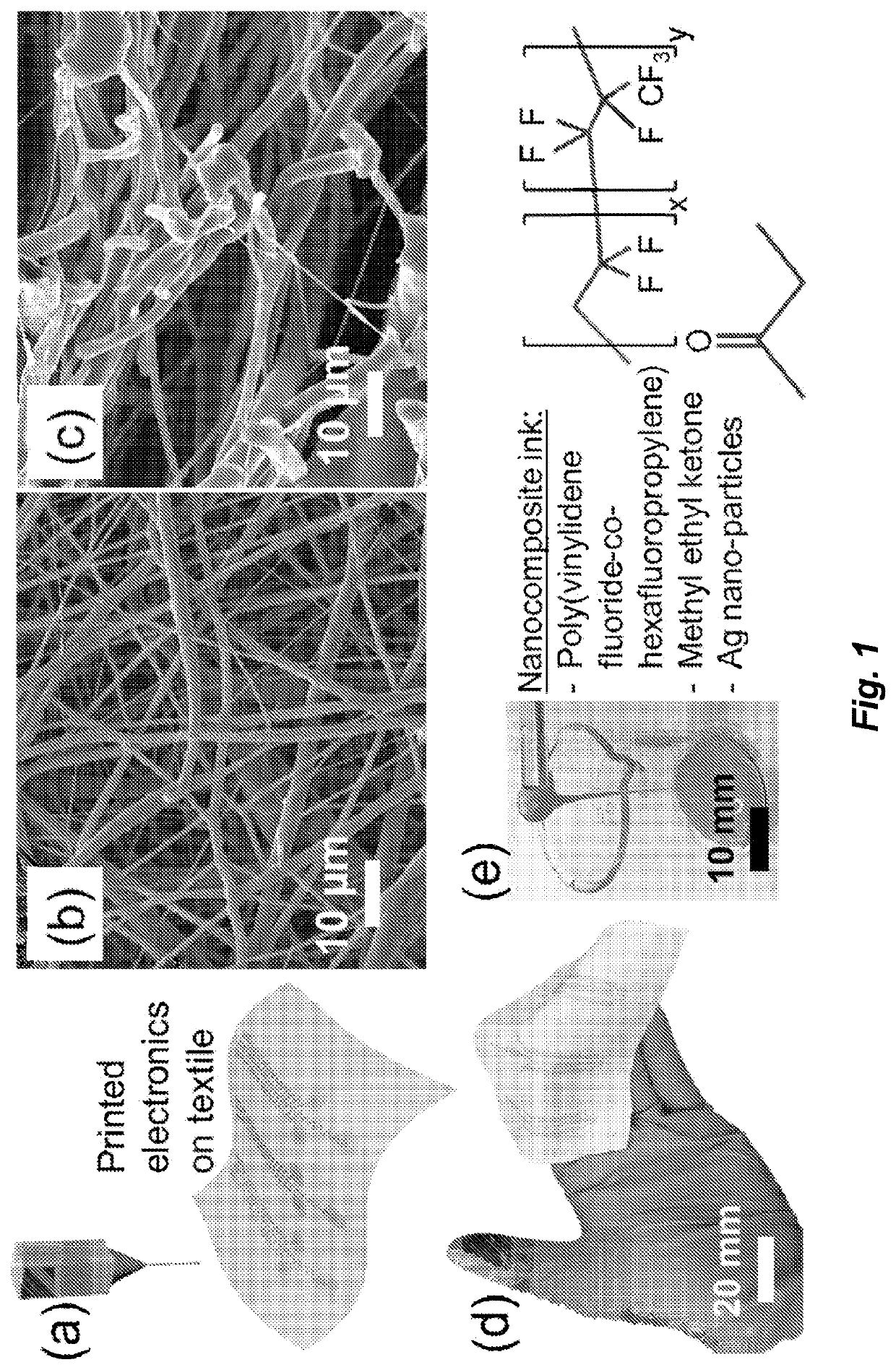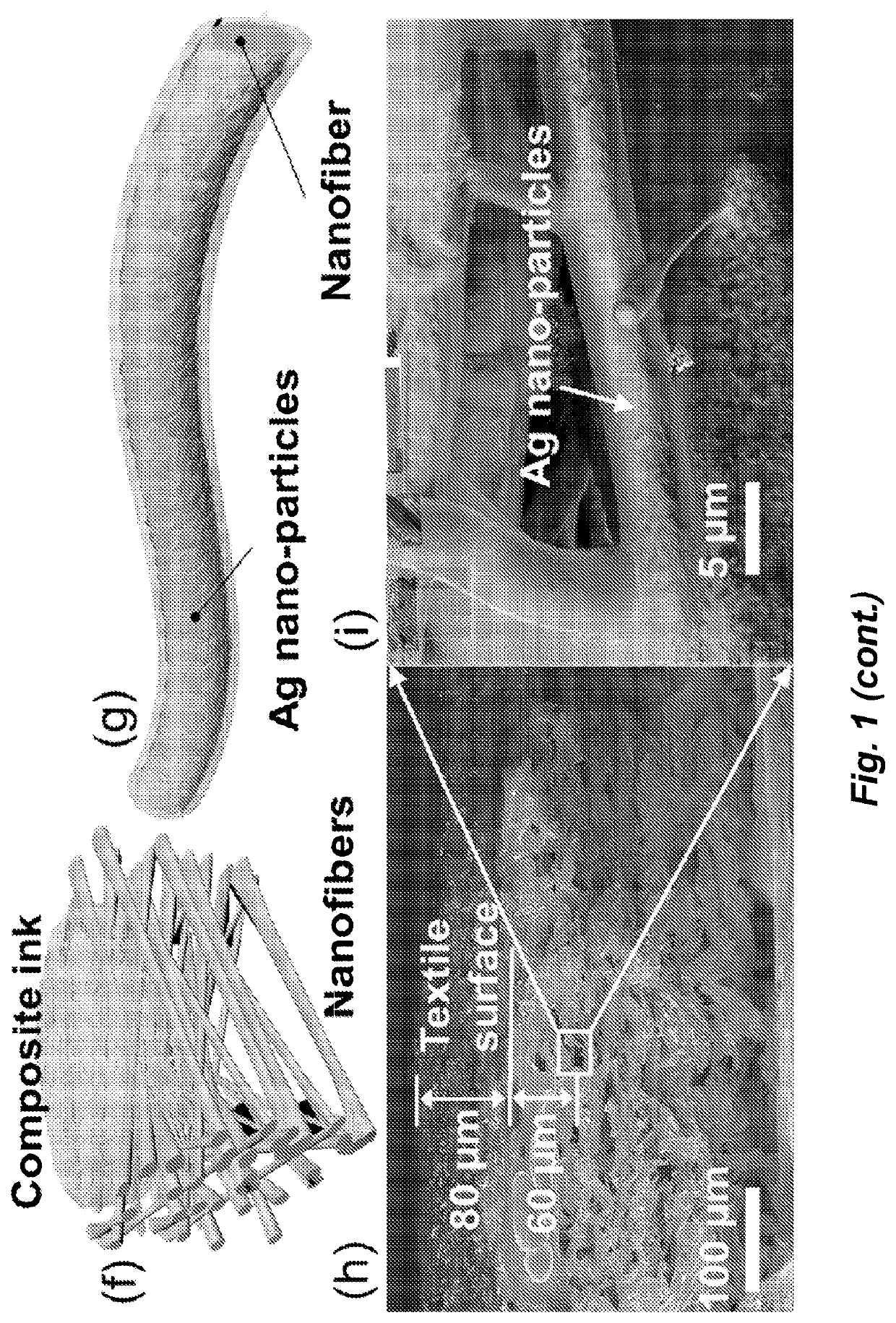Elastic printed conductors
a technology of printed conductors and conductors, applied in the field of elastic printed conductors, can solve the problems of mechanical stiffening, thermal degradation of most of daily fabrics, and limited miniaturization and flexibility of the strategy
- Summary
- Abstract
- Description
- Claims
- Application Information
AI Technical Summary
Benefits of technology
Problems solved by technology
Method used
Image
Examples
example 1
Ink Preparation
[0094]Fluoroelastomer (DAI-EL G801, Daikin Industries) and butanone (Sigma Aldrich) were mixed with weight ratio of 1:2.55. After stirring with a magnetic stirrer for 6 hours, silver flakes (Sigma Aldrich, average particle size of 2-3.5 μm, >99.9% trace metals basis) were added to the solution in a 2.5:1 (silver:fluoroelastomer) weight ratio and mixed with magnetic stirrer for 4 h. 10 minutes sonication was applied to the solution to get well-dispersed stretchable silver ink. All procedures are carried out at room temperature.
example 2
of Composite Ink
[0095]The prepared ink (FIG. 6a) was loaded to a syringe (FIG. 6b) which is specifically designed for the nScrypt Tabletop-3Dn printer (FIG. 6c). A sheet of electrospun polyurethane nanofibers (Technical Datasheet of the material, see (42)) was cut in a rectangular shape of 120 mm×120 mm and pre-treated in oxygen plasma for 10 mins. The textile sheet was placed in the printer bed which was kept at room temperature during printing. To print the stretchable interconnects, the prepared ink was loaded to a syringe. For one-time printing, an amount of 10 mL was used. The printed sample (FIG. 6d) was dried in vacuum chamber at room temperature for 8 hours.
example 3
ded e-Textile Biosensors
[0096]After printing and drying, the samples which were printed on one side were flipped to the other side and loaded to the printer. The samples were carefully positioned by a laser marking of the printer to achieve well aligned two-side circuit. After printing the circuits on two side, via interconnects (from one to another side) were formed by using a very small needle (⅜″ diameter) that was dip-coated by the prepared ink to puncture through the thickness of the textile one-time. The double-sided e-textile can be used for a surface electromyography (sEMG) system to monitor muscles activities or an electroencephalography (EEG) system to record brain waves. Other biological sensing applications of the e-textile include, for example, electrocardiography (ECG), electrooculography (EOG), respiratory rate, heart rate, mechanical strain, pressure, temperature, and / or vibration sensors.
PUM
| Property | Measurement | Unit |
|---|---|---|
| pore size | aaaaa | aaaaa |
| depth | aaaaa | aaaaa |
| diameter | aaaaa | aaaaa |
Abstract
Description
Claims
Application Information
 Login to View More
Login to View More - R&D
- Intellectual Property
- Life Sciences
- Materials
- Tech Scout
- Unparalleled Data Quality
- Higher Quality Content
- 60% Fewer Hallucinations
Browse by: Latest US Patents, China's latest patents, Technical Efficacy Thesaurus, Application Domain, Technology Topic, Popular Technical Reports.
© 2025 PatSnap. All rights reserved.Legal|Privacy policy|Modern Slavery Act Transparency Statement|Sitemap|About US| Contact US: help@patsnap.com



